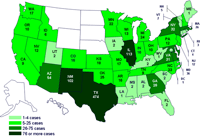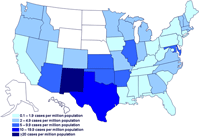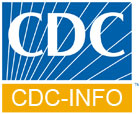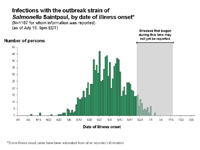Skip directly to the search box, site navigation, or content.
Investigation of Outbreak of Infections Caused by Salmonella Saintpaul
Cases infected with the outbreak strain of Salmonella Saintpaul, United States, by state, as of July 16, 2008 9pm EDT

Incidence of cases of infection with the outbreak strain of Salmonella Saintpaul, United States, by state, as of July 16, 2008 9PM EDT

Update for July 17, 2008 - Case count information as of 9 pm EDT, July 16, 2008
Click Here for Advice to Consumers
CDC is collaborating with public health officials in many states, the Indian Health Service, and the U.S. Food and Drug Administration (FDA) to investigate an ongoing multi-state outbreak of human Salmonella serotype Saintpaul infections. An initial epidemiologic investigation in New Mexico and Texas comparing foods eaten by persons who were ill in May to foods eaten by well persons identified consumption of raw tomatoes as strongly linked to illness. A similar but much larger, nationwide study comparing persons who were ill in June to well persons found that ill persons were more likely to have recently consumed raw tomatoes, fresh jalapeño peppers, and fresh cilantro. These items were commonly, though not always, consumed together, so that study could not determine which item(s) caused the illnesses.
Recently, many clusters of illnesses have been identified in several states among persons who ate at restaurants. Most clusters involve fewer than 5 ill persons. Three larger clusters have been intensively investigated. In one, illnesses were linked to consumption of an item containing fresh tomatoes and fresh jalapeño peppers. In the other two, illnesses were linked to an item containing fresh jalapeño peppers and no other of the suspect items. The accumulated data from all investigations indicate that jalapeño peppers caused some illnesses but that they do not explain all illnesses. Raw tomatoes, fresh serrano peppers, and fresh cilantro also remain under investigation. Investigators from many agencies are collaborating to track the source of the implicated peppers and other produce items.
Since April, 1220 persons infected with Salmonella Saintpaul with the same genetic fingerprint have been identified in 42 states, the District of Columbia, and Canada. These were identified because clinical laboratories in all states send Salmonella strains from ill persons to their State public health laboratory for characterization. No new states report ill persons. The number of ill persons identified in each state is as follows: Alabama (2 persons), Arkansas (16), Arizona (54), California (9), Colorado (16), Connecticut (4), Florida (2), Georgia (28), Idaho (6), Illinois (113), Indiana (16), Iowa (2), Kansas (18), Kentucky (2), Louisiana (1), Maine (1), Maryland (36), Massachusetts (26), Michigan (24), Minnesota (22), Mississippi (2), Missouri (17), New Hampshire (5), Nevada (12), New Jersey (12), New Mexico (102), New York (32), North Carolina (23), Ohio (10), Oklahoma (25), Oregon (10), Pennsylvania (12), Rhode Island (3), South Carolina (2), Tennessee (9), Texas (474), Utah (2), Virginia (31), Vermont (2), Washington (17), West Virginia (1), Wisconsin (13), and the District of Columbia (1). Five ill persons are reported from Canada; four appear to have been infected while traveling in the United States, and one illness remains under investigation.
Among the 1167 persons with information available, illnesses began between April 10 and July 4, 2008, including 625 who became ill on June 1 or later. These numbers include those with estimated onset dates as well as those with reported onset dates. Patients range in age from <1 to 99 years; 50% are female. The rate of illness is highest among persons 20 to 29 years old; the rate of illness is lowest in children 5 to 19 years old and in persons 80 or more years old. At least 224 persons were hospitalized. A man in his eighties who died in Texas from cardiopulmonary failure had an infection with the outbreak strain at the time of his death; the infection may have contributed to his death. A man in his sixties who died in Texas from cancer had an infection with the outbreak strain of at the time of his death; the infection may have contributed to his death.
The outbreak can be visually described with a chart showing the number of persons who became ill each day. This chart is called an epidemic curve or epi curve. The epi curve and information about interpreting it may be found here. It shows that the number of persons who became ill peaked during May and decreased in June. The average number of persons who became ill between May 20 and June 10 was 33 per day. The average number of persons who became ill between June 11 and June 20 was 19 per day. Illnesses that occurred after June 20 may not yet be reported due to the time it takes between when a person becomes ill and when the illness is reported. This takes an average of 2-3 weeks. The outbreak appears to be ongoing, but with fewer new illnesses each day. Please see the Salmonella Outbreak Investigations: Timeline for Reporting Cases for more details.
Only 6 persons infected with this strain of Salmonella Saintpaul were identified in the country during April through June of 2007. The previous rarity of this strain and the distribution of illnesses in all U.S. regions suggest that the implicated food is distributed throughout much of the country. Because many persons with Salmonella illness do not have a stool specimen tested, it is likely that many more illnesses have occurred than those reported. Some of these unreported illnesses may be in states that are not on today’s map.
Health officials have worked continuously since late May to investigate this outbreak. CDC has sent 29 people to the field to work with other public health officials. The investigation is complex and difficult. One difficult aspect is that people often have difficulty remembering exactly what foods they ate, and remembering specific ingredients in those foods is even more difficult. Although laboratory testing of foods might help identify the source, perishable foods that were consumed by ill persons are often not available to test. When food items are mixed together and consumed in the same dish, all the items may be statistically linked to illness. In that case, determining by statistical means which item caused the illness can be difficult or impossible. Tracing suspect produce items back to processors and growers is an integral part of the effort to identify a single source and a possible means of contamination.
Clinical features of Salmonella Infection
Most persons infected with Salmonella develop diarrhea, fever, and abdominal cramps 12-72 hours after infection. Infection is usually diagnosed by culture of a stool sample. The illness usually lasts 4-7 days. Although most people recover without treatment, severe infections may occur. Infants, elderly persons, and those with impaired immune systems are more likely than others to develop severe illness. When severe infection occurs, Salmonella may spread from the intestines to the bloodstream and then to other body sites, and can cause death. In these severe cases, antibiotic treatment may be necessary.
Advice to consumers
Until health officials know that the contaminated product or products are no longer on the market, persons with increased risk of severe infection, including infants, elderly persons, and those with impaired immune systems, should not eat raw jalapeño peppers or raw serrano peppers. FDA has indicated that tomatoes on the market today are safe to consume.
FDA information on this investigation can be found at: http://www.fda.gov/oc/opacom/hottopics/tomatoes.html*
More information about Salmonella and this investigation can be found at:
- Salmonella FAQ
- Timeline for Reporting of Cases
- New Mexico Department of Health
 (PDF – 191 KB)
(PDF – 191 KB) - Arizona Department of Health Services News Release - Tomatoes: Caution Urged*
- Texas Department of State Health Services - News Update, June 13, 2008*
- Kansas Identifies 3 Cases Linked to Multi-State Salmonella Outbreak*
- Kentucky Cabinet for Health and Family Services Press Release
- Indiana State Department of Health Media Update on Salmonella Outbreak*
- Maryland Department of Health and Mental Hygiene News Release
- Missouri DHHS: State health department issues cautions about tomatoes*
- New Jersey Department of Health and Human Services: NJ Reports Four Salmonella Cases Linked to Multi-State Outbreak
- Utah Department of Health: Health News
Information on the safe handling of produce can be found at: www.cfsan.fda.gov/~dms/prodsafe.html.*
Previous Updates on this Outbreak
- July 16, 2008
- July 15, 2008
- July 14, 2008
- July 11, 2008
- July 10, 2008
- July 9, 2008
- July 8, 2008
- July 7, 2008
- July 4, 2008
- July 3, 2008
- July 2, 2008
- July 1, 2008
- June 30, 2008
- June 27, 2008
- June 26, 2008
- June 25, 2008
- June 24, 2008
- June 23, 2008
- June 20, 2008
- June 18, 2008
- June 16, 2008
- June 12, 2008
- June 9, 2008
- June 7, 2008
- June 5, 2008
- June 2, 2008
* Links to non-Federal organizations found at this site are provided solely as a service to our users. These links do not constitute an endorsement of these organizations or their programs by CDC or the Federal Government, and none should be inferred. CDC is not responsible for the content of the individual organization Web pages found at these links.
![]() Please note: Some of these publications are available for download only as *.pdf files. These files require Adobe Acrobat Reader in order to be viewed. Please review the information on downloading and using Acrobat Reader software.
Please note: Some of these publications are available for download only as *.pdf files. These files require Adobe Acrobat Reader in order to be viewed. Please review the information on downloading and using Acrobat Reader software.
Content Source: National Center for Zoonotic, Vector-Borne, and Enteric Diseases (ZVED)
Languages
Quick Links
Contact CDC


